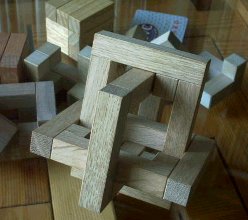|
Mine’s Cube in Cage 333
This puzzle, new to my collection in 2004, rapidly became one of my all-time favourites. It has so many of the classic requirements for a superb puzzle. Mental change, aesthetic appeal, pleasing tactile response, difficult every time, several different options… I could go on, but here’s an initial look at this puzzling masterpiece.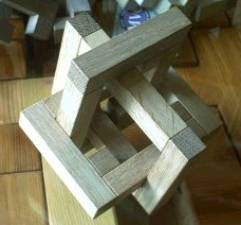
Mine's Cube has many secrets, all of them mentally simulating which is why it's common to see them lying around the office space, faculties, etc. The left picture shows the puzzle in its ‘out of the box’ position. It consists of three wooden frames measuring 4 inches by 3 inches, one in each plane. Two are identical. The ‘odd’ one is simply a bare frame, 7x5 units. The other two are 7x5 unit frames with an additional unit cube in the two corners along one 7-unit side. Both pictures show an extra cube in the corner at the bottom. The picture below shows the solved puzzle, with a credit card for size guidance. The three frames are interlocked in such a way that they cannot be separated. Careful observation will show that the void at the centre of the three frames is just large enough to take a 3x3x3 cube.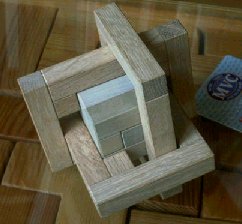 By coincidence, the puzzle comes with not one, but four 3x3x3 cubes! Can this really be a coincidence? Careful examination of each of the 3x3x3 cubes will show that they are actually 3-piece cube assemblies. Three of the cubes easily separate, while the other one is a 3-move sequential disassembly! By now, you may well have guessed the object of the puzzle. The four cubes must each be assembled, in turn, inside the sliding frames. By coincidence, the puzzle comes with not one, but four 3x3x3 cubes! Can this really be a coincidence? Careful examination of each of the 3x3x3 cubes will show that they are actually 3-piece cube assemblies. Three of the cubes easily separate, while the other one is a 3-move sequential disassembly! By now, you may well have guessed the object of the puzzle. The four cubes must each be assembled, in turn, inside the sliding frames.
Designer Mineyuki Uyematsu says,
“It is easy for most of you to assemble 4 different cubes, each of which consists of 3 pieces, outside the cage, but I believe it is quite difficult for you to make up each cube inside the cage. Each cube has a different secret.”
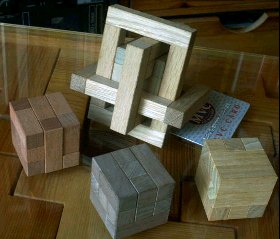 The wood used for each cube is different - Big Leaf Magnolia, Moabi, Mobingi and Walnut. I have solved the puzzle for the cube which Mine says is easiest, but, as he points out, "...you may find difficulty in a different way from how I have judged!" The ‘easy’ cube is probably the most interesting, as it is the most complex to assemble outside the cage. Solving the puzzle requires that each cube is initially assembled externally, then inserted piece by piece, into the cage, generally with significant trial and error and sliding of the frames. The wood used for each cube is different - Big Leaf Magnolia, Moabi, Mobingi and Walnut. I have solved the puzzle for the cube which Mine says is easiest, but, as he points out, "...you may find difficulty in a different way from how I have judged!" The ‘easy’ cube is probably the most interesting, as it is the most complex to assemble outside the cage. Solving the puzzle requires that each cube is initially assembled externally, then inserted piece by piece, into the cage, generally with significant trial and error and sliding of the frames.
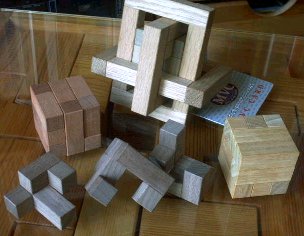 The actual craftsm anship, by Taichi Tsuchiya of the Tsuchiya Woodworking Plant, is beyond criticism. The frames of the cage slide exquisitely. There is just a hair’s breadth between each piece. It is a remarkable work of great skill. When you consider how many different ways there must be of designing a three-piece 3x3x3 cube assembly, Mine has done an amazing job, selecting four of the best to make this delightful puzzle a true landmark in my collection. Even though I have solved one cube, it will be a new experience next time, I’m sure! The actual craftsm anship, by Taichi Tsuchiya of the Tsuchiya Woodworking Plant, is beyond criticism. The frames of the cage slide exquisitely. There is just a hair’s breadth between each piece. It is a remarkable work of great skill. When you consider how many different ways there must be of designing a three-piece 3x3x3 cube assembly, Mine has done an amazing job, selecting four of the best to make this delightful puzzle a true landmark in my collection. Even though I have solved one cube, it will be a new experience next time, I’m sure!
|


 By coincidence, the puzzle comes with not one, but four 3x3x3 cubes! Can this really be a coincidence? Careful examination of each of the 3x3x3 cubes will show that they are actually 3-piece cube assemblies. Three of the cubes easily separate, while the other one is a 3-move sequential disassembly! By now, you may well have guessed the object of the puzzle. The four cubes must each be assembled, in turn, inside the sliding frames.
By coincidence, the puzzle comes with not one, but four 3x3x3 cubes! Can this really be a coincidence? Careful examination of each of the 3x3x3 cubes will show that they are actually 3-piece cube assemblies. Three of the cubes easily separate, while the other one is a 3-move sequential disassembly! By now, you may well have guessed the object of the puzzle. The four cubes must each be assembled, in turn, inside the sliding frames.  The wood used for each cube is different - Big Leaf Magnolia, Moabi, Mobingi and Walnut. I have solved the puzzle for the cube which Mine says is easiest, but, as he points out, "...you may find difficulty in a different way from how I have judged!" The ‘easy’ cube is probably the most interesting, as it is the most complex to assemble outside the cage. Solving the puzzle requires that each cube is initially assembled externally, then inserted piece by piece, into the cage, generally with significant trial and error and sliding of the frames.
The wood used for each cube is different - Big Leaf Magnolia, Moabi, Mobingi and Walnut. I have solved the puzzle for the cube which Mine says is easiest, but, as he points out, "...you may find difficulty in a different way from how I have judged!" The ‘easy’ cube is probably the most interesting, as it is the most complex to assemble outside the cage. Solving the puzzle requires that each cube is initially assembled externally, then inserted piece by piece, into the cage, generally with significant trial and error and sliding of the frames. The actual craftsm anship, by Taichi Tsuchiya of the Tsuchiya Woodworking Plant, is beyond criticism. The frames of the cage slide exquisitely. There is just a hair’s breadth between each piece. It is a remarkable work of great skill. When you consider how many different ways there must be of designing a three-piece 3x3x3 cube assembly, Mine has done an amazing job, selecting four of the best to make this delightful puzzle a true landmark in my collection. Even though I have solved one cube, it will be a new experience next time, I’m sure!
The actual craftsm anship, by Taichi Tsuchiya of the Tsuchiya Woodworking Plant, is beyond criticism. The frames of the cage slide exquisitely. There is just a hair’s breadth between each piece. It is a remarkable work of great skill. When you consider how many different ways there must be of designing a three-piece 3x3x3 cube assembly, Mine has done an amazing job, selecting four of the best to make this delightful puzzle a true landmark in my collection. Even though I have solved one cube, it will be a new experience next time, I’m sure!